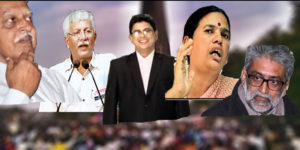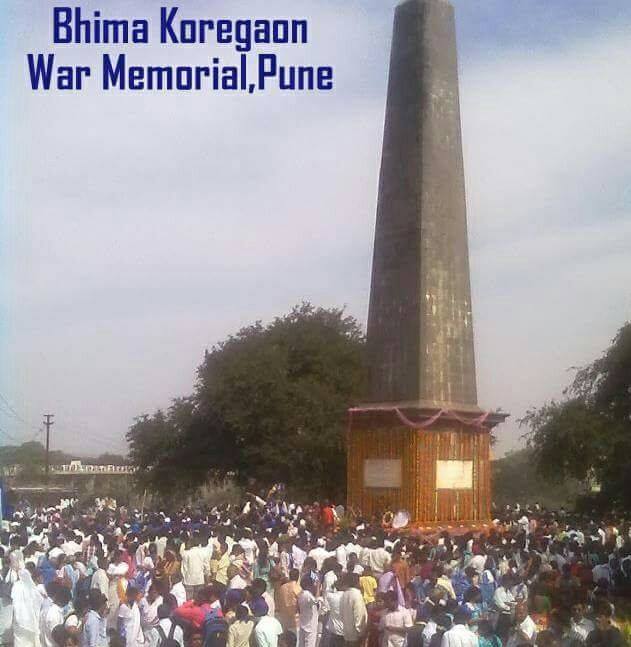10 Arrests in 8 Months of Bhima-Koregaon Riots
SPOTLIGHT ON TWO PROMINENT CASES IN MAHARASHTRA State police working on both cases, but not without political challenges; while FIR was filed seven days after Bhima-Koregaon violence, Maha police, which is probing Pansare murder case, and CBI, which is pursuing Dabholkar murder case, had not made breakthrough for long
On January 8, seven days after the Bhima Koregaon violence in Pune, the city police filed an FIR claiming that provocative speeches made at the Elgar Parishad on December 31 led to the Bhima -Koregaon riots.
The Elgar Parishad was organised by former Bombay HC Judge BG Kolse Patil and retired Supreme Court Judge PB Sawant. The FIR mentions the names of six people. While one was a Dalit activist, Sudhir Dhawale, the other five belonged to Kabir Kala Manch some of whose members have been accused by past governments of helping Maoists. On the basis of the FIR, Pune Police registered a case under Sections 153 (A) and 505 of the IPC, which pertain to creating enmity between communities.
On June 6, Pune Police moved swiftly and arrested Dhawale from Mumbai. However, they also arrested others whose names were not there in the FIR like Nagpur-based lawyer Surendra Gadling, activists Mahesh Raut and Shoma Sen from Nagpur and Rona Wilson from Delhi. The Pune police claimed that besides inciting the Bhima Koregaon violence, the five have also been charged under the Unlawful Activities (Prevention) Act. The police alleged that they found communication from Rona Wilson’s home in Delhi on discussions about a ‘Rajiv Gandhi type incident’ and attempts to procure M4 rifles. On August 28, Pune police arrested five more people from across the country –– Maoist ideologue Varavara Rao from Hyderabad and human rights activists Gautam Navlakha, Sudha Bharadwaj, Vernon Gonsalves and Arun Ferreira. Pune police claimed that the searches at their homes had provided them more evidence on how the accused were not only trying to ‘destabilise’ the government but also trying to ‘assassinate political figures’ and were in touch with Kashmiri separatists and planning to get arms and ammunition into the country from Russia and China via Nepal.

The Supreme Court has, however, intervened into the arrests made on August 28 and has directed that those arrested be kept under house arrest till September 6 when it hears their case.
Pune police have claim that they have strong evidence against all the accused like letters written by the accused to Maoists talking about the need for violence to target security forces. Basically, the Pune police, within six months of the Bhima Koregaon riots, managed to unveil the conspiracy to not only create riots but also assassinate political figures and overthrow the government. It has managed to find out that arms were to be brought in the country for this purpose.
Dabholkar Murdered: 2013; Pansare in 2015; Cases Cracked: 2018
KARNATAKA TIP-OFF HELPS M’RASHTRA SOLVE KILLINGS OF RATIONALISTS
ai:
Two sensational murders –– that of Narendra Dabholkar in 2013 and Govind Pansare in 2015 –– which the Maharashtra police failed to crack, is now seeing a breakthrough through the involvement of the Karnataka police. Ironically, it was the police sleuths from the neighbouring state, who were on the Gauri Lankesh murder trail on Maharashtra soil, that led to crucial tip-offs leading to some breakthrough in the Dabholkar/Pansare cases as well.
On 20 August, 2013, rationalist Narendra Dabholkar was shot dead during his morning walk in Pune. The Pune police launched a search for his assailants for close to two years but made no breakthrough. Following this, in May 2014, the case was handed over to the CBI.
Two years later, on February 16, 2015, Communist Party of India leader Govind Pansare was also shot at. He died four days later. The Maharashtra Police, which is investigating the Pansare murder case, and the CBI which is pursuing the Dabholkar murder case, had not made any breakthroughs until August this year when the Karnataka police tipped off the ATS (anti-terrorism squad) after cracking the Gauri Lankesh murder case. On August 9, the Maharashtra ATS arrested Vaibhav Raut, a man alleged to be affiliated to the Sanathan Sanstha –– a right wing radical outfit whose members were always under suspicion –– for the murders of both Dabholkar and Pansare. Raut’s arrest came after a tip off from the Karnataka SIT to the Maharashtra police. Raut’s arrest led not only to the recovery of several homemade bombs, but also to the arrests of Sharad Kalaskar and Sudhwana Gondhalekar. Kalaskar’s was the key arrest because it is now being alleged that he, along with one Sachin Andhure who was arrested on August 18, were the ones who pulled the trigger on Narendra Dabholkar.
There are already many loopholes to this charge as the CBI itself has claimed earlier in court that Sarang Akolkar and Vinay Pawar were the ones who shot Dabholkar.
While there have been more arrests in the case, the ATS and CBI have not been able to say as to which organisation the men belonged to. Interestingly, the key player involved in the murders of Dabholkar, Pansare and Gauri Lankesh is one Amol Kale. Kale, a resident of Pune and who lives in Bengaluru, was arrested on May 21 this year by the Karnataka SIT investigating the Lankesh murder case.
Kale allegedly belongs to the Hindu Janajagruti Samiti –– an offshoot of the Sanathan Sanstha.
Economic Times


September 7, 2018 at 4:23 pm
The difference in enquiry suggests double standards and attitude of partiality towards some cases